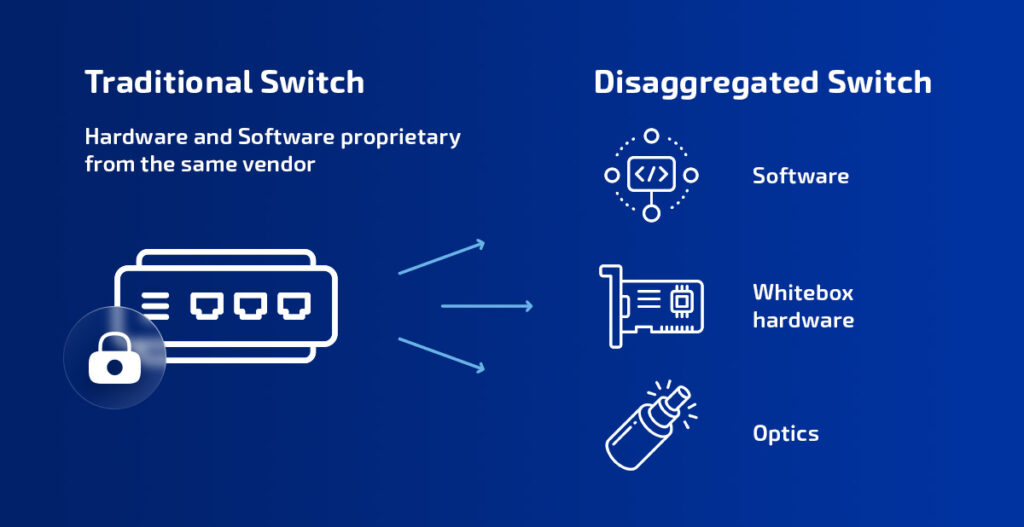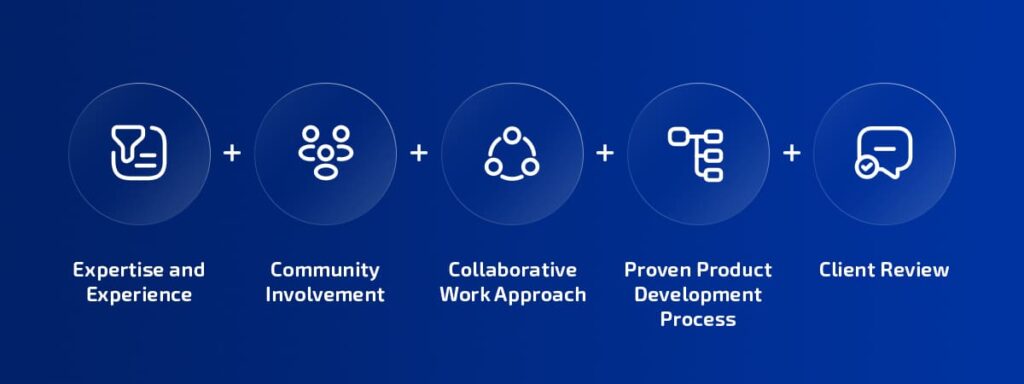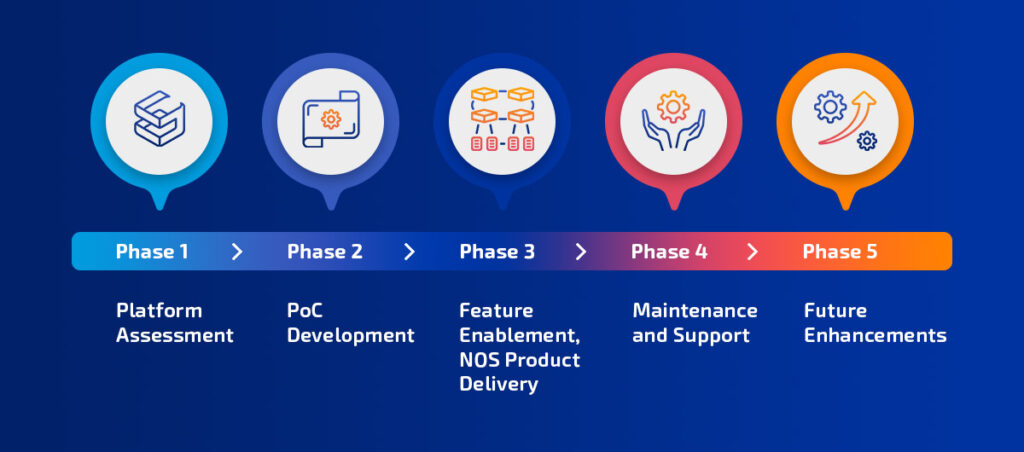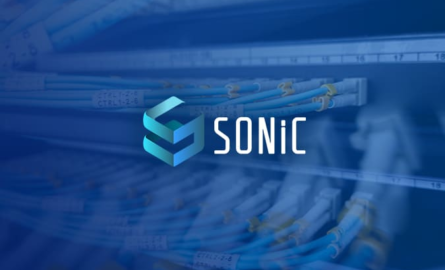Explore the details of transitioning from proprietary network operating systems to open-source SONiC, understanding key considerations in making the right move. Dive deeper into the journey of choosing your own customized SONiC distribution, unraveling the intricacies involved in developing, deploying, and maintaining a tailored system that aligns with your organizational needs.
CONTENTS
Cutting Infrastructure Costs: Transition From Proprietary NOS to Open System
Сompanies which oversee their data centers and network infrastructure find themselves compelled to upgrade their hardware every few years to stay on top of market demands. The annual financial commitment for software licenses and ongoing support costs also pose recurring challenges. Even with substantial financial investments and a well-coordinated system in place, many companies still experience a lack of full control, leading to reliance on updates and changes dictated by their software vendor.
Autonomy is becoming an increasingly attractive goal as companies grapple with inevitable questions about how to reduce operational expenses for their networks. In such scenarios, companies are increasingly considering transitioning from a proprietary Network Operating System (NOS) to an open-source alternative like SONiC (Software for Open Networking in the Cloud).
Diving into the world of SONiC reveals a few complexities that can create bumps on the path to the open-source promised land. While the idea of grabbing the SONiC source code from GitHub and setting it up may seem straightforward, the reality is often more intricate. It is not simply a matter of having the software, but also of aligning it seamlessly with the specific demands of individual businesses.
That is why the industry has witnessed a surge in the popularity of ready-to-use SONiC distributions offered by specific companies. These distributions are meticulously designed and developed to cater to different use cases, extending SONiC’s reach beyond just hyperscale environments. Built on open-source SONiC, these distributions offer the advantages of SONiC’s community innovations. Tailored enhancements make them suitable for enterprises and their data center environments. These offerings provide a safety net by including robust support services.
In essence, these packaged SONiC solutions present a practical and efficient alternative, but it is crucial to note that this format does not suit everyone. It often requires regular payments, creating an ongoing financial commitment. Additionally, dependency on a vendor remains, even though the software is open-source. This reliance can limit autonomy, and the tailored enhancements may not perfectly align with every organization’s unique needs. Furthermore, updates and modifications might not be as agile as desired.
There is also a different path which requires SONiC customization, steering organizations towards a journey that involves more than just a quick installation, but a complete ownership of a customized SONiC distribution. Vendor independence is crucial for these organizations, as it ensures control over their software. Some may seek to cultivate internal expertise and build a team capable of handling their customized SONiC. Alternatively, companies might choose to have their own SONiC but use the services of an experienced product development vendor. Such a vendor could commit to providing 24/7 Tier 3 support, catering to particularly complex and rare scenarios. Additionally, they can develop on-demand features, providing a flexible and tailored approach. This option is also widespread in the industry, and we will delve below into key considerations when opting to take ownership of your own SONiC version.
 Traditional Switch vs. Disaggregated Switch: A Comparison
Traditional Switch vs. Disaggregated Switch: A Comparison
Choosing SONiC Autonomy: Internal Mastery or External Partnership
Organizations face a critical decision regarding their SONiC strategy – some prioritize the autonomy and control inherent in managing their SONiC version, while others see the value in partnering with an external vendor for targeted support and ongoing development requirements.
To achieve complete independence by managing SONiC on your own involves not just attracting skilled professionals, but also investing significantly in establishing and sustaining a robust lab infrastructure. This path demands a substantial commitment of both time and financial resources.
Therefore, it is critical to conduct a strategic evaluation, aligning your long-term vision with the desired level of vendor independence that best serves your organizational objectives:
Internal Expertise
Flexibility vs. External Support
Cost-Benefit Analysis
Long-Term Sustainability
Security
Compliance
Need a production-ready SONiC tailored to your needs? Speed up your time to market, acquire comprehensive knowledge, and gain total control of your software with PLVision. Explore our offering and get in touch
Key Considerations in Choosing a SONiC Customization Partner
When considering a partnership with a vendor for SONiC customization, there are several critical aspects to focus on in making the right choice. Look for a vendor dedicated to delivering a production-ready SONiC, which addresses your unique feature gaps and ensures the solution is vendor-neutral, eliminating subscription fees and licensing costs for third-party providers. PLVision exemplifies this approach by providing efficient, customized solutions based on open NOS.
Seek out partners offering comprehensive training and support, as you may choose to use their services to acquire necessary knowledge or entrust them with support for your SONiC solution. Also, opt for a firm which values open communication, understands your goals, and collaborates effectively. Vendors which to the community stay informed about project developments, and often possess well-defined roadmaps and proven track records. This ensures a smoother journey towards your customized SONiC solution.

Benefits of a Customized SONiC Solution
Navigating the Path to Your Customized SONiC
Developing a custom SONiC distribution involves several key phases. In the initial SONiC and platform assessment phase, a comprehensive evaluation takes place. This involves examining a specific SONiC version in alignment with the unique network design needs of your end-users. The process entails matching capabilities and requirements, conducting risk and gap analyses, and establishing a clear product vision. Critical decisions include the selection of a suitable hardware platform and determining the most fitting version of SONiC.
In the subsequent prototyping phase, efforts are focused on validating your SONiC solution’s Proof of Concept for the defined use case. Next comes the product delivery phase, which involves hardening and extending critical SONiC features, for example, BGP, VXLAN, MC-LAG etc. It also involves developing test cases, a comprehensive knowledge base, and extending automated tests to qualify the complete product using the community test infrastructure.
Up next is the maintenance and support phase. It typically offers flexibility based on your unique case. A proficient vendor can empower your team with essential knowledge for self-support, allowing you to independently manage your SONiC-based product. Alternatively, you may choose continuous support from the same vendor, ensuring ongoing assistance from the experts who helped craft your solution. This phase opens avenues for various approaches, tailored to your preferences and the level of autonomy you seek in maintaining and enhancing your SONiC deployment.
Concluding the journey is the future enhancement phase, presenting diverse options for progression. Hiring a vendor’s services remains one avenue, and you can leverage their expertise for continuous improvements such as additional platform support or evolving feature development. On the other hand, if your organization boasts an adept, in-house team, you could instead opt to autonomously evolve your distribution.
Each of these phases contributes significantly to the successful development, deployment, and ongoing support of your customized SONiC distribution tailored to your organization’s specific needs.
It is essential to note that not all companies have the inclination to handle every aspect of developing their own custom SONiC distribution. Some enterprises may require assistance with specific components of the process. For instance, companies like PLVision offer services tailored to these specific needs, providing support in targeted areas as well as in the entirety of the development lifecycle.
 Phases of Developing Custom SONiC Distribution
Phases of Developing Custom SONiC Distribution
If a company intends to own and independently maintain its distribution, it becomes paramount for them to ensure their engineers possess the necessary knowledge and skills for effective SONiC management. Ideally, the vendor should be prepared to offer live SONiC training sessions covering fundamental aspects such as disaggregated networking, SONiC user fundamentals, key feature configuration, and typical data center use cases. Moreover, it is beneficial for the vendor to provide comprehensive documentation specific to the company’s product and offer guidance on maintenance procedures.
An excellent approach is to have interactive communication with the instructors during the training process, allowing for consultations and specific questions related to the company’s use case. This should include access to presentations, video materials, and practical exercises through a user-friendly educational platform to empower the company’s engineers with the knowledge and skills required for successful SONiC deployment and ongoing maintenance.
Conclusion
The transition from proprietary NOS to open-source alternatives, particularly SONiC, has become a sensible strategic move for companies seeking to enhance control over their network infrastructure and reduce operational costs. However, this journey is not without its intricacies. As organizations contemplate the shift, they face the dilemma of whether to opt for a pre-packaged hardened SONiC from specific vendors or to embark on a path of complete ownership of a customized distribution, delivered by an experienced partner committed to multi-dimensional vendor-neutrality.
This journey is definitely not a one-size-fits-all transition. It requires careful consideration of organizational priorities, capabilities, and long-term goals.
Let's discuss your software development needs!
- How AI and Networking Are Rewiring Each Other – and Why Open Networking Matters - October 15, 2025
- PLVision’s SONiC-Based Services: Accelerating Open-Source Network Transformation - September 3, 2025
- SONiC Lite for Edge and Campus: Powering Your Digital Independence - August 18, 2025



